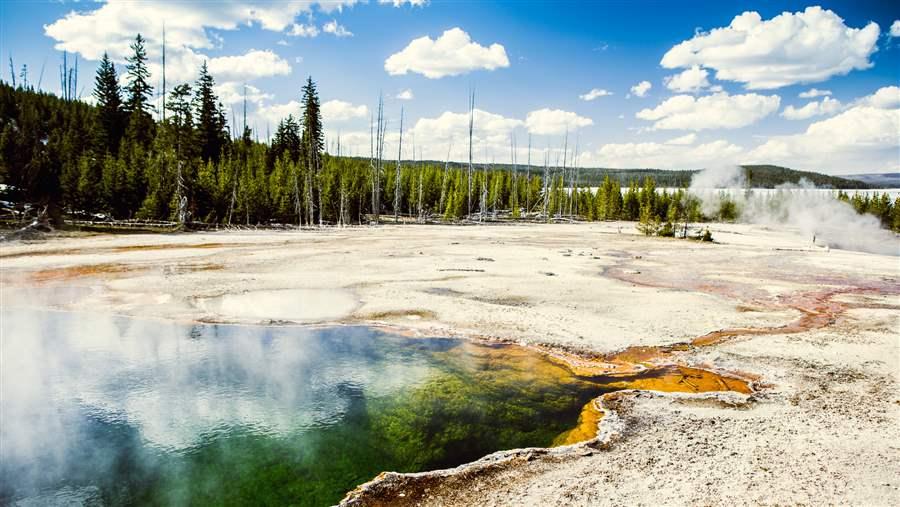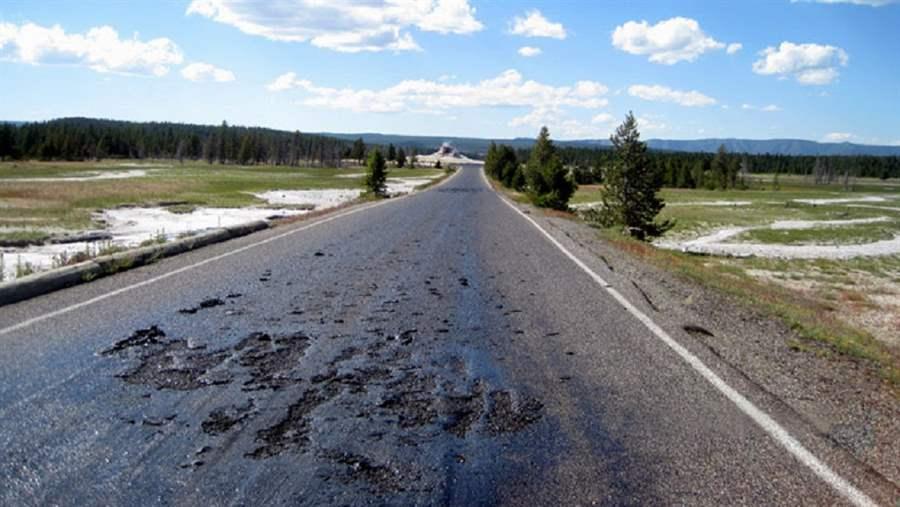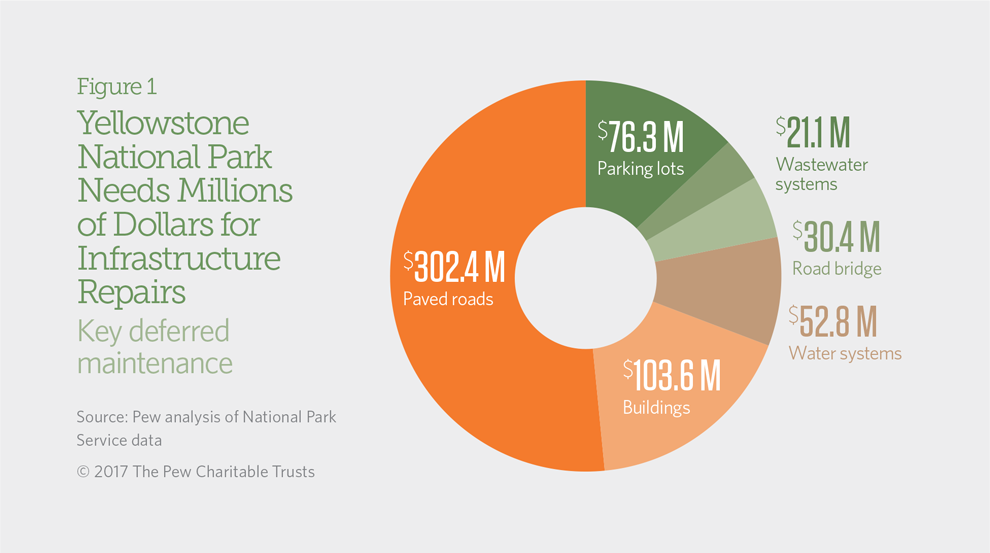Yellowstone National Park
Idaho, Montana, and Wyoming

To access Yellowstone’s amazing hydrologic features, visitors take the Grand Loop Road, a 142-mile-long thoroughfare completed in 1905 that is 22 feet across at its widest and has no shoulders.4
© iStockphoto
Pew created this case study using National Park Service deferred maintenance data issued in fiscal year 2015. The information listed here may no longer reflect the NPS site’s current condition or maintenance requirements. To find the most up-to-date information, please use the National Park Repair Needs tool.
This case study was updated on July 31, 2017, to reflect newly released 2016 data and to correct references to calendar and fiscal year.
Overview
Yellowstone is America’s first national park, established in 1872. Spanning nearly 3,500 square miles in the northwest corner of Wyoming and parts of Montana and Idaho, the park is unique for what lies below it: a volcanic hot spot.1 The hundreds of hot springs and geysers at the surface, including Old Faithful, make up about half of the world’s geothermal features.2 Yellowstone’s spectacular landscape also features canyons, rivers, and forests that are home to bears, wolves, bison, elk, antelopes, and hundreds of other species.
The largely unspoiled park offers a glimpse of what the continent looked like before recorded history. This year-round destination has a vast network of hiking trails that reach hundreds of secluded places. Fishing is also popular, and anglers are allowed to keep some of their catch.3 Old Faithful isn’t the only iconic spot to draw visitors: Grand Canyon of the Yellowstone and Yellowstone Lake are also familiar sights that have been documented in dozens of paintings and photographs. Unfortunately, getting to these attractions can be time-consuming because of heavy traffic and antiquated roads. Repairing these roads is part of a $630 million maintenance backlog at the park.
Yellowstone National Park needs more than $630 million in repairs, including road damage near the Firehole River.

Yellowstone National Park has more than $630 million in deferred maintenance, including road damage near the Firehole River.
© National Park ServiceMaintenance challenges
To access Yellowstone’s amazing hydrologic features, visitors take the Grand Loop Road, a 142-mile-long thoroughfare completed in 1905 that is 22 feet across at its widest section and has no shoulders.4 The National Park Service began upgrading it in 1988 but has reconstructed only about half of the loop and entrance roads, which add 112 more miles.5 It says it lacks the funding needed to complete the rest. The improvements have been guided mostly by safety issues, because the narrow lanes must accommodate RVs, cyclists, and pedestrians in addition to automobiles. Traffic often slows to a crawl as visitors pause to view the park’s abundant wildlife. Completing the modernization will cost more than $300 million, half of Yellowstone’s infrastructure repair needs.
More than 800 of the park’s buildings—museums, hotels, and park ranger and employee housing—also have deferred maintenance, estimated at more than $100 million. More than 20 percent of these buildings are considered historic.6 An example is the pump house museum, which examines how the Madison River was used to support railroad operations in West Yellowstone.7 Also is in need of repair is the Yellowstone Heritage and Research Center, which houses natural and cultural artifacts, including watercolor sketches of the park by Thomas Moran and photographs by William Henry Jackson.8 A building holding the park’s vehicle collection, including early stagecoaches operated by the Yellowstone Park Transportation Co., needs more than $7 million in repairs.
Yellowstone’s extensive water and wastewater systems also need repairs to ensure uninterrupted service for visitors. The park treats over 300 million gallons of water annually from 15 public and six nonpublic water systems and distributes that water through 600,000 feet of service lines.9 The park also operates a tertiary wastewater facility, five secondary treatment facilities, 32 sewage lift stations, and 21 septic systems with subsurface drain fields.10 The deferred maintenance cost for all water and wastewater systems is more than $70 million.
Yellowstone National Park was the reason we located our family’s fly-fishing business at the west entrance to the park nearly 40 years ago. Since then, thousands of our customers have been introduced to the sport and conservation. There’s so much public streams and lakes with native and wild trout that we must ensure the park is maintained so people can continue to experience it.Craig Mathews, Blue Ribbon Flies, West Yellowstone, Montana
Recommendations
To address the deferred maintenance needs at Yellowstone and other NPS sites across the country, Congress should:
- Ensure that infrastructure initiatives include provisions to address park maintenance.
- Provide dedicated annual federal funding for national park repairs.
- Enact innovative policy reforms to ensure that deferred maintenance does not escalate.
- Provide more highway funding for NPS maintenance needs.
- Create more opportunities for public-private collaboration and donations to help restore park infrastructure.
Yellowstone National Park Facts
2016
|
Visitor spending |
$524.3 million |
|
Jobs created by visitor spending |
8,200 |
|
Economic output |
$680.4 million |
|
Labor income |
$238.5 million |
|
Visits |
4,257,177 |
|
Deferred maintenance (fiscal year 2015) |
$632.3 million |
Sources: National Park Service, “Annual Visitation Reports by Years: 2005 to 2015,” accessed Aug. 25, 2016, <a href="https://irma.nps.gov/Stats/ SSRSReports/National%20Reports/Annual%20Visitation%20By%20Park%20(1979%20-%20Last%20Calendar%20Year)" target="_blank">https://irma.nps.gov/Stats/SSRSReports/National Reports/Annual Visitation By Park (1979 - Last Calendar Year);National Park Service, “Visitor Spending Effects,” accessed Aug. 22, 2016,https://www.nps.gov/subjects/socialscience/vse.htm; National Park Service, “NPSDeferred Maintenance Reports,” accessed Aug. 19, 2016, https://www.nps.gov/subjects/ plandesignconstruct/defermain.htm(Pew converted National Park Service data from this webpage and other NPSsources into a searchable database)
© 2017 The Pew Charitable Trusts
© 2017 The Pew Charitable Trusts
Endnotes
- National Park Service, “Yellowstone Park Facts,” accessed Sept. 26, 2016, https://www.nps.gov/yell/planyourvisit/parkfacts.htm
- National Park Service, “Hydrothermal Features,” accessed Sept. 26, 2016, https://www.nps.gov/yell/learn/nature/hydrothermal-features.htm.
- National Park Service, “Yellowstone National Park Fishing Regulations,” accessed Nov. 18, 2016,
- https://www.nps.gov/yell/planyourvisit/upload/15FishReg_revisionTW.pdf.
- National Park Service, “Yellowstone National Park Road Reconstruction,” accessed Sept. 26, 2016, https://www.nps.gov/transportation/pdfs/ Yellowstone_Roads_Reconstruction.pdf.
- Ibid.
- National Park Service, “Yellowstone National Park Business Plan,” accessed Sept. 23, 2016, https://www.nps.gov/yell/learn/management/upload/YNP-Business-Plan-2003.pdf.
- Yellowstone Historic Center, “Historic District: Water Tower & Pump House,” accessed Sept. 28, 2016, http://yellowstonehistoriccenter.org/Water-Tower/.
- National Park Service, “Yellowstone Museum Collection,” accessed Sept. 23, 2016, https://www.nps.gov/yell/learn/historyculture/museum.htm.
- National Park Service, “Yellowstone National Park Business Plan.”














